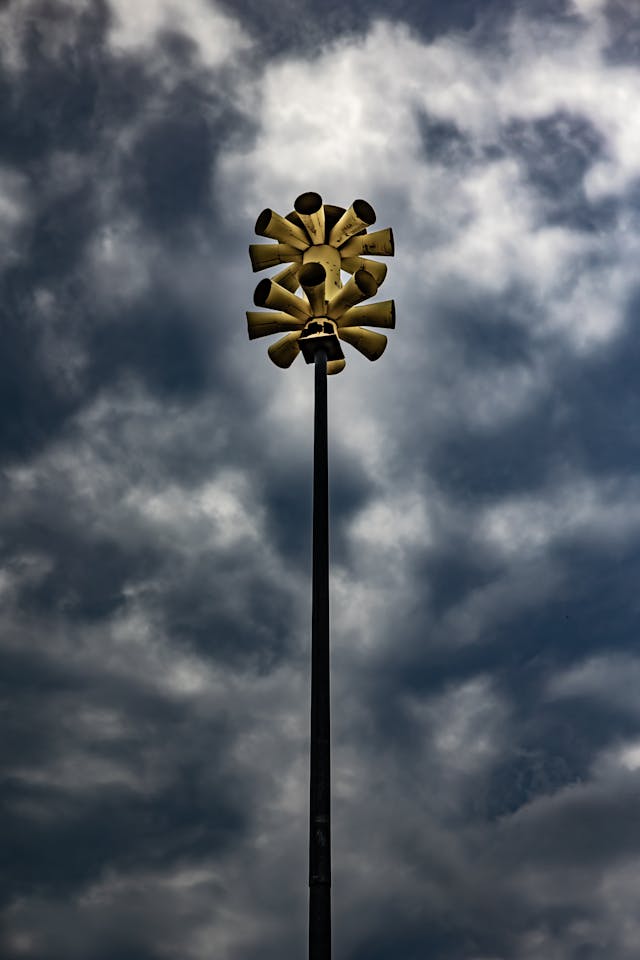
You know the sound. It's a plaintive wailing from afar, reminiscent of the air raid sirens of WWII. With it comes an adrenaline rush and instant anxiety. It's a warning to take cover as a dangerous storm approaches. You probably never give these warning systems a second thought – until you hear one.
Sirens of one type or another have been around since 1799, when Scotsman John Robison invented one to use as a musical instrument. His inspiration used a wheel to open and close a stopcock in organ pipes, effectively fluttering and creating a pitch. I'm not sure he ever dreamed his invention would someday warn the masses of incoming bombs, because bagpipes were probably sufficient to make people run and take cover.

The name "siren" was coined in 1819 by Baron Charles Cagniard de la Tour. His improved version used a rotating perforated disk that generated tones as air moved between it and a stationary disk. Because it worked under water, Cagniard apparently was inspired to name it after the sirens of Greek mythology. Or he was just thinking about women.
Since the late 1800s, most mechanical sirens have used a rotating cylinder instead of discs. A fan pushes air through an inner rotating cylinder with slots all around its edge (like open doorways). As it rotates, air is forced out through similar slots in a stationary external cylinder wall, creating sound. The first sirens were cranked by hand, but compressed air, and eventually electric motors turned the fan blades and cylinder.
Mechanical sirens give us that distinctive "wailing" sound, like sirens singing to Odysseus. As the cylinder spins up to speed, the pitch rises. When air flow is stopped it spins down, the pitch falling. This crying sound of mechanical technology has imprinted generations of people with the urgency of self preservation. Even animals react to sirens, triggering animal instincts.
Electronic sirens, at their core, are amplified speakers that employ an oscillator. The first "wailing" siren was invented in 1965 by Motorola. These are probably the most common type found today because they can also play voice announcements, different tones and warning signals, and can withstand extreme elements with very little maintenance.
Pneumatic sirens that use compressed air are still found today. They usually rely on tanks of compressed air and can conserve electricity, but require more maintenance.
So which system is the best? It all depends on local circumstances and guidelines. The electronic systems seem to be the most adaptable, as they don't rely on only one sound. They can also play voice announcements. In my community, the city has electronic sirens placed in large public places such as parks. The intent is to warn anybody that is outside, not someone that is in their home or car. With rapid warnings via phones, TV, and radio, most city dwellers will be aware of any emergency.
Although I can hear the warning system less than a mile away at my house, it's difficult to understand any voice announcements. Inside my house I can just make out the tones, which are similar to London's Big Ben clock. In weather emergencies, the incoming wind will usually carry away or mask the audio alerts. However, I've been within a city block of one and heard it quite clearly.
The mechanical and pneumatic sirens seem to have a higher output over electronic sirens, but not by much. My hunch is that the wailing and two-tone mechanical sirens would be best for long distance and penetrating structures. The pitch, especially as the wail is held briefly at the highest note, is right in the most sensitive part of our hearing. Before my city replaced the warning system, they used a wailing-type siren that I could hear clearly from my house. Not so much for the bell tones.
Want one for yourself? You can buy a hand-crank one for $30 that gets really loud, a 12V motor one for about $40, and one rated for outdoor spaces like schools and factories for $200. For communities, the cost is much higher. In addition to supplying utilities and communications to each warning site, factor in a tower or pole, multiple units for omnidirectional sound, and annual maintenance. Planning, zoning changes, and training also factor in. Sirens with a half-mile range start at $7-10K alone, and go right up from there.
Want to hear some scary tornado sirens?
Watch on TikTok here.
And here.
Tags: Tornado, Siren, Alert, Alarm




